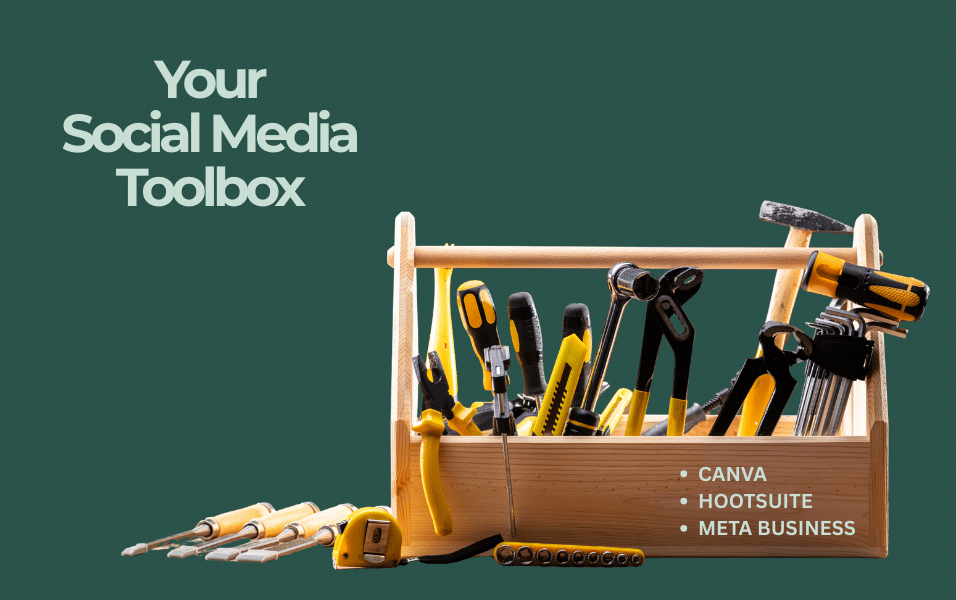Let’s be real—as a small business owner, you’re already wearing about fifteen different hats. You probably didn’t plan to become a ‘social media expert’ when you started your business. But here’s the thing: 93.79% of businesses use social media, and 41% depend on social media to drive revenue. The good news? You don’t need to become a social media wizard overnight. You just need the right tools.
Free Tools That Deliver Big Results
Canva is probably already on your radar, and for good reason. It’s the design equalizer that lets you create professional-looking graphics without needing a design degree or a hefty budget. Canva’s Brand Kit feature (available in their free version) lets you save your brand colours, fonts, and logos. This means every post you create automatically stays on-brand, even when you’re rushing between meetings.
Meta Business Suite is Facebook’s free scheduling tool. While it only handles Facebook and Instagram, it offers something most paid tools charge extra for: detailed audience insights and the ability to schedule Instagram Reels. However, it has some limitations—it’s clunky and doesn’t integrate smoothly with other platforms.
The Paid Tool Difference: Why Scheduling Software Is Worth It
Here’s where things get interesting. Businesses using social media scheduling tools can save an average of 6-8 hours per week on content planning and posting tasks, and by scheduling posts during peak activity hours, businesses have reported a 50% increase in engagement.
The big advantage of paid scheduling software over Meta’s free tool? Cross-platform posting. Instead of logging into Facebook, then Instagram, then LinkedIn, then TikTok (you get the picture), tools like Buffer, Hootsuite, or Later let you manage everything from one dashboard. Buffer’s free plan is good enough for small businesses to line up a week or so’s worth of posts. If you want a more complete social media management solution or to control more than three social media accounts at once, you’ll need to pay $6/month per social channel for the Essentials plan.
But wait, there’s more: the analytics are incredibly detailed. Free tools give you basic metrics, but most paid scheduling software shows you when your audience is most active across different platforms. This isn’t just vanity data—it’s the difference between posting content in hopes it gets seen and actually reaching people who might choose to do business with you.
Underrated Hidden Gems
Tailwind isn’t just another scheduling tool—it’s specifically built for Pinterest and Instagram, with AI-powered hashtag suggestions that actually work. With email marketing features, this tool might be a good choice for small businesses that want to do it all in one platform. For businesses in visual industries (such as restaurants, retail, or home services), Tailwind can be a huge timesaver.
Planable offers something most competitors don’t: visual content calendars that your whole team can collaborate on, even on the free plan. Planable is one of the best free social media schedulers according to recent reviews, and it’s particularly great for businesses that need approval workflows.
Repurposing tools such as Repurpose.io provide users with a great way to get more mileage out of their work and connect with a larger audience. Instead of creating brand-new content for every platform every time, using tools that can automatically resize and reformat content is much more efficient.
Creating a Cohesive Strategy
Helping small businesses sort through the noise to find solutions that fit their reality is exactly what we at MYOB do best. Choosing the right tools is not only about features but also about creating a system that fits your schedule and budget.
Because at the end of the day, the tools are just that—tools. The real magic happens when you combine them with authentic content that actually helps your customers. Whether you’re using free Meta scheduling or paying for premium analytics, the question remains the same: are you using these tools to build genuine relationships with people who need what you’re selling?
Over to You
Social media tools should make your life easier, not more complicated. Begin by exploring free options, analyzing where you invest the most time, and then consider investing in tools that help you reclaim that time. Whether you choose free tools or invest in premium software, the most important metric isn’t your follower count—it’s whether your social media efforts are actually driving customers through your door.
Every business is unique, and the social media strategies you select should align with your specific requirements. If you need guidance, we’re here to assist you. Let’s chat about the available options.

